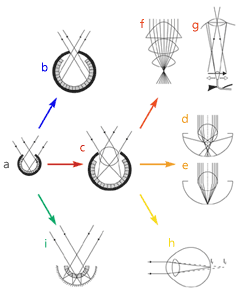
Click image to enlarge Fig. 2 The likely evolution of single-chambered eyes. Arrows indicate functional developments, not specific evolutionary pathways. From Land and Fernald [4]. |
To be useful to their owners, eyes must collect light from the environment, resolve it into images, and then capture and forward those images to the brain. Despite decades of research, we still have only limited understanding of how vision actually works. It remains a deep puzzle how a seamless representation of the world is knitted together by the brain from visual snapshots. The functioning of the eye itself, however, is fairly well understood. This is, in part, because the evolution of eyes has been strictly constrained by the physical properties of light. Light travels in straight lines, can be reflected, and varies in wavelength (subjective hue or color) and intensity (subjective brightness). Many of the structural principles and even apparent flaws we find in existing eyes result from constraints due to the physical properties of light.
By the time of the Cambrian period (570–500 million years ago), eyes were present in the form of very simple eyecups, useful for detecting light but not for processing directional information. Although the causes are unknown, explosive speciation, or the 'Big Bang' of animal evolution happened during the Cambrian [3]. Existing eye types improved radically, coincident with the appearance of carnivory and predation. The evolution of ocular structures has proceeded in two stages (fig. 2) [4]. First was the production of simple eye spots which are found in nearly all the major animal groups and contain a small number of receptors in an open cup of screening pigment [4]. Such detectors cannot play a role in recognizing patterns but are useful for distinguishing light from dark. The second stage in eye evolution is the addition of an optical system that can produce an image. Image-forming eyes occur in 96% of known species distributed among 6 phyla [4]. Among the known eye types are at least eleven distinct optical methods of producing images, the most recently described is a telephoto lens, identified in the chameleon in 1995. Indeed, six of the optical mechanisms have only been discovered in the past 25 years.
Since camera-type eyes are demonstrably superior in several respects [5], why don't all animals have them? Certainly, camera-type eyes require big heads and bodies to hold them which may have restricted the number of animals that have followed this evolutionary path. Also, it is likely that having evolved one eye type, conversion to another type requires intermediate stages that are much worse or useless compared with the existing design. This would make a switch essentially lethal to animals that depend on sight. Although this argument makes sense intuitively, some existing cases of novel optical combinations suggest this is probably not the whole story.
Textbooks tend to group animal eyes into two groups, the camera-type or 'simple' eyes and the compound eyes. Although this dichotomy reflects a real and fundamental difference in optical mechanisms, it conceals a remarkable diversity of optical systems subsumed under each heading [4, 5].
In 1994, Nilsson and Modlin described a mysid shrimp (Dioptromysis paucispinous) that has a combined simple and compound eye: partly compound with multiple facets exactly like the eye of an insect, and partly simple with a single lens focusing an image on a sheet of receptors like that of a human. The shrimp are about 5 mm long with nearly spherical eyes at the ends of stalks. In addition to the facets (ca. 800–900) there is a single giant facet facing the shrimp's tail, which the shrimp frequently rotates forward probably to get a better look at something since it has ca. 5 times the acuity (but much lower sensitivity) than the rest of the eye. It is as if the shrimp is carrying a pair of binoculars for the occasional detailed look at something ahead of it. The discovery that simple and compound eye types can be found in a single animal raises the question of how a developmental program could produce this outcome.
The Evolution of Eyes
Why Do We See What We See?
How Do Eyes Work and How Did They Evolve?
How Do Eyes Capture Photons?
Where Do Lenses Come From?
Eyes: Convergence or Homology?
Conclusions
References
Biography
>> next